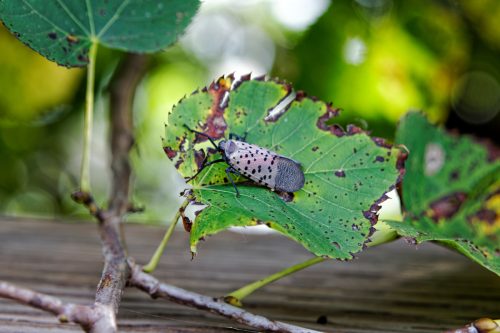If You Have This Common Plant in Your Yard, “Eliminate It” Now, Experts Say

Whether you have a small garden or an expansive backyard, it’s nice to enjoy any greenery, shrubs, flowers, or trees growing outside your home. You may even invest time and money in hiring a landscaper to design and decorate your outdoor space. But unfortunately, some plants that you might consider pretty additions are actually dangerous to have in your yard. Experts have issued a new warning about one plant variety that you’ll want to clear out sooner rather than later. Read on to find out what you need to “eliminate” from your backyard.
READ THIS NEXT: If You Have This Common Tree in Your Yard, Prepare to Cut It Down, Officials Say.
There are ongoing conversations about invasive species.

The topic of invasive species has become more prevalent lately, considering the damage being done by the spotted lantern fly and the emerald ash borer. To be classified as invasive, animals, plants, or living species (like insects) must be non-native and “likely to cause economic or environmental harm or harm to human health,” according to the U.S. Department of Agriculture (USDA) National Invasive Species Information Center.
You might think you can easily spot a non-native plant or bug. But the truth is, several of these species have been present in the U.S. for hundreds of years and have become commonplace. You can even purchase dangerous varieties unknowingly at your local garden center or Home Depot. Now, experts are warning about one invasive plant that you can recognize by its sweet fragrance.
This vine smells nice, but it doesn’t act nice.

Honeysuckle is well-known for its pleasant scent and pretty blooms, but don’t let these attributes fool you. Japanese honeysuckle (Lonicera japonica) is an invasive species first introduced in Long Island, New York, in the 1800s for ornamental purposes, according to the USDA.
It’s concerning due to its ability to outcompete native species for both light and “below-ground resources,” according to the Purdue University Invasive Plant Species Assessment Working Group, growing up to 30 feet in length.
“It also has strong self-rooting stems that don’t take long to spread,” Vera Kutsenko, nature enthusiast and founder and CEO of the online home garden and lawn marketplace Neverland, previously told Best Life. “This creates a hostile network of creeping roots that smother all foliage in its path, making it difficult to control.”
According to Purdue, its vines can grow successfully on top of other plants, twining around them to form a “dense blanket” of shade that makes it impossible for other plants to survive.
READ THIS NEXT: If You Have This Tree in Your Yard, Kill It and Cut It Down, Experts Warn.
Japanese honeysuckle is more common than you’d think, and it’s easily spread.

Despite its known dangers, Japanese honeysuckle is sold at garden centers and is now widespread in the U.S., with positive reports in 44 states, according to EDDMapS data. Your encounters with the plant could date back to childhood, Herrick Brown, biology professor at the University of South Carolina (USC) and curator for the A.C. Moore Herbarium, told Carolina News & Reporter.
“As a kid, I have always enjoyed picking the green bulb inside the flower,” Brown said. “When you smash it with your fingers, you get sort of a honey scent. I think people may have fond memories doing this as kids and don’t realize how invasive the plant is.”
Crushing up and dropping the flowers elsewhere also helps the plant to proliferate, and when the flowers turn into berries in the summer, birds will eat them and spread the seeds elsewhere, according to the Missouri Department of Conservation. Considering the damage that Japanese honeysuckle can cause to communities and wildlife, experts ask that you get rid of it if you have it.
The invasive plant has distinct features.

You can recognize Japanese honeysuckle by a few different attributes, depending on the season and how old the plant is. You can look for its green “finely-haired” stems when the plant is young, or woody brown stems on those that are older, according to the University of Maryland (UMD) Extension.
Its trumpet-like flowers are present between April and July, starting out white with a pink and purple tinge, then turning yellow. Between September and November, you can keep an eye out for ripened “black, shiny berries,” as well as leaves that are “egg-shaped, hairy, and smooth-edged.”
RELATED: For more up-to-date information, sign up for our daily newsletter.
If you spot it, get rid of it.

If you identify one of these vines in your yard, take action before it spreads further, experts say.
“The main thing is to eliminate it in your yard or whatever property you may be responsible for,” Jordan Franklin, consumer horticulture agent with the Clemson Home and Garden Information Center, told Carolina News & Reporter. “It can be a big job, depending on the size of the growth. If you can, remove it and prevent it from growing.”
In larger areas, prescribed burning can effectively kill and stop the spread of Japanese honeysuckle, but this probably isn’t necessary outside of your home. The infestation in your yard could be small, and UMD Extension recommends removing vines and any berries you find by hand. If the infestation is expansive and pulling doesn’t solve your honeysuckle problem, you can move on to herbicides, namely glyphosate and triclopyr. Application is most successful in the spring through the fall, according to the university.